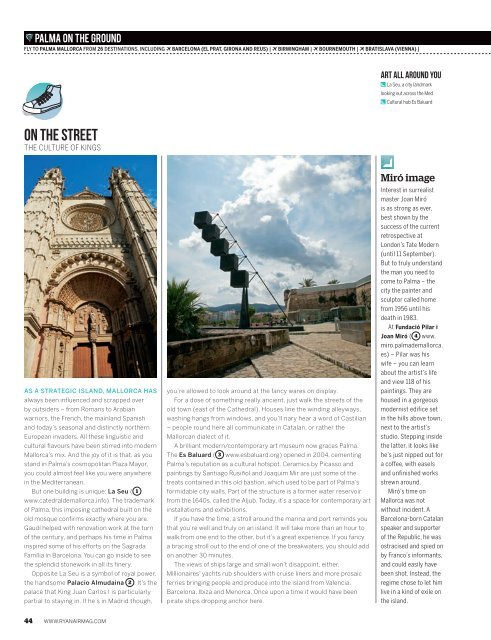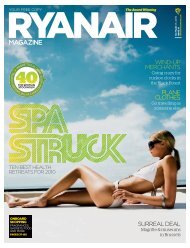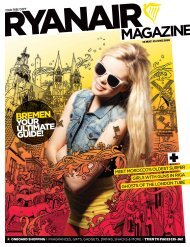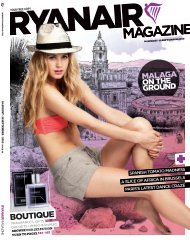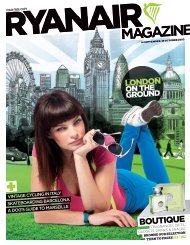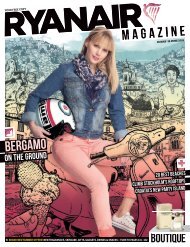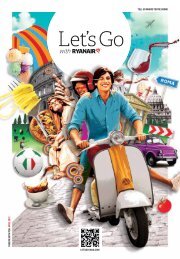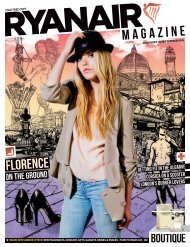july-2011
july-2011
july-2011
Create successful ePaper yourself
Turn your PDF publications into a flip-book with our unique Google optimized e-Paper software.
PALMA ON THE GROUND<br />
FLY TO PALMA MALLORCA FROM 26 DESTINATIONS, INCLUDING BARCELONA (EL PRAT, GIRONA AND REUS) | BIRMINGHAM | BOURNEMOUTH | BRATISLAVA (VIENNA) |<br />
ON THE street<br />
THE CULTURE OF KINGS<br />
AS A STRATEGIC ISLAND, MALLORCA HAS<br />
always been influenced and scrapped over<br />
by outsiders – from Romans to Arabian<br />
warriors, the French, the mainland Spanish<br />
and today’s seasonal and distinctly northern<br />
European invaders. All these linguistic and<br />
cultural flavours have been stirred into modern<br />
Mallorca’s mix. And the joy of it is that, as you<br />
stand in Palma’s cosmopolitan Plaza Mayor,<br />
you could almost feel like you were anywhere<br />
in the Mediterranean.<br />
But one building is unique: La Seu ( 1<br />
www.catedraldemallorca.info). The trademark<br />
of Palma, this imposing cathedral built on the<br />
old mosque confirms exactly where you are.<br />
Gaudí helped with renovation work at the turn<br />
of the century, and perhaps his time in Palma<br />
inspired some of his efforts on the Sagrada<br />
Família in Barcelona. You can go inside to see<br />
the splendid stonework in all its finery.<br />
Opposite La Seu is a symbol of royal power,<br />
the handsome Palacio Almudaina 2 . It’s the<br />
palace that King Juan Carlos I is particularly<br />
partial to staying in. If he’s in Madrid though,<br />
44 WWW.RYANAIRMAG.COM<br />
you’re allowed to look around at the fancy wares on display.<br />
For a dose of something really ancient, just walk the streets of the<br />
old town (east of the Cathedral). Houses line the winding alleyways,<br />
washing hangs from windows, and you’ll nary hear a word of Castilian<br />
– people round here all communicate in Catalan, or rather the<br />
Mallorcan dialect of it.<br />
A brilliant modern/contemporary art museum now graces Palma.<br />
The Es Baluard ( 3 www.esbaluard.org) opened in 2004, cementing<br />
Palma’s reputation as a cultural hotspot. Ceramics by Picasso and<br />
paintings by Santiago Rusiñol and Joaquim Mir are just some of the<br />
treats contained in this old bastion, which used to be part of Palma’s<br />
formidable city walls. Part of the structure is a former water reservoir<br />
from the 1640s, called the Aljub. Today, it’s a space for contemporary art<br />
installations and exhibitions.<br />
If you have the time, a stroll around the marina and port reminds you<br />
that you’re well and truly on an island. It will take more than an hour to<br />
walk from one end to the other, but it’s a great experience. If you fancy<br />
a bracing stroll out to the end of one of the breakwaters, you should add<br />
on another 30 minutes.<br />
The views of ships large and small won’t disappoint, either.<br />
Millionaires’ yachts rub shoulders with cruise liners and more prosaic<br />
ferries bringing people and produce into the island from Valencia,<br />
Barcelona, Ibiza and Menorca. Once upon a time it would have been<br />
pirate ships dropping anchor here.<br />
art ALL AROUND YOU<br />
La Seu, a city landmark<br />
looking out across the Med<br />
Cultural hub Es Baluard<br />
Miró image<br />
Interest in surrealist<br />
master Joan Miró<br />
is as strong as ever,<br />
best shown by the<br />
success of the current<br />
retrospective at<br />
London’s Tate Modern<br />
(until 11 September).<br />
But to truly understand<br />
the man you need to<br />
come to Palma – the<br />
city the painter and<br />
sculptor called home<br />
from 1956 until his<br />
death in 1983.<br />
At Fundació Pilar i<br />
Joan Miró ( 4 www.<br />
miro.palmademallorca.<br />
es) – Pilar was his<br />
wife – you can learn<br />
about the artist’s life<br />
and view 118 of his<br />
paintings. They are<br />
housed in a gorgeous<br />
modernist edifice set<br />
in the hills above town,<br />
next to the artist’s<br />
studio. Stepping inside<br />
the latter, it looks like<br />
he’s just nipped out for<br />
a coffee, with easels<br />
and unfinished works<br />
strewn around.<br />
Miró’s time on<br />
Mallorca was not<br />
without incident. A<br />
Barcelona-born Catalan<br />
speaker and supporter<br />
of the Republic, he was<br />
ostracised and spied on<br />
by Franco’s informants,<br />
and could easily have<br />
been shot. Instead, the<br />
regime chose to let him<br />
live in a kind of exile on<br />
the island.


